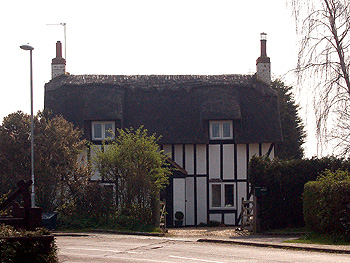32 Wood Lane Cotton End
![32 Wood Lane in 1960 [Z53/38/9]](/CommunityHistories/CottonEnd/CottonEndImages/32 Wood Lane in 1960 [Z53-38-9].jpg)
32 Wood Lane in 1960 [Z53/38/9]
The Bedfordshire Historic Environment Record [HER] contains information on the county’s historic buildings and landscapes and summaries of each entry can now be found online as part of the Heritage Gateway website. 32 Wood Lane [HER 1698] is dated to the 17th or 18th centuries. It is a timber framed cottage with roughcast render and a thatched roof and was formerly listed by the Department of Environment as Grade III, being de-listed when that grade of listing was abolished.
We are fortunate that three surveys of the parish of Cardington from the late 18th century survive. The first of these was undertaken in 1782 by James Lilburne. He was the parish schoolmaster and later agent for Samuel Whitbread, who owned large estates in the parish and also the sole Enclosure Commissioner for the parish. He produced a list of all the inhabitants of the parish arranged by house and hamlet [P38/28/1]. This was published, with extensive analysis by County Archaeologist David Baker in 1973 as Bedfordshire Historical Record Society Volume 52.
Since publication a second list has been found [P38/28/2]. It carries revisions up to the year 1789. Sadly neither of these surveys includes a map. Finally, in 1794 Lilburne produced another survey [W2/6/1-3] and this one had a map with a key showing where each house was. One can use this to plot the houses of the previous surveys and this work was carried out by John Wood of Bedfordshire County Council’s Conservation Section in October 1982 [CRT130Cardington29].
The 1782 survey [P38/28/1/2] shows that 32 Wood Lane was occupied by Edward King, a 28 year old labourer who had been born in Cople and died on 25th June 1783. He was a dissenter, that is, a nonconformist in religion. His wife was 27 year old Susanna, née Wilson, who had been born at “Sheerpread” [Shepreth] in Cambridgeshire and spun linen and Jersey. Jersey was a woollen fabric much used in the manufacture of underwear. Their children were: Elizabeth, aged 1½ and Judith who was born on 29th March 1782 and died on 20th June 1787. In 1782 the couple moved to another cottage in Cotton End.
By 1784 Thomas Groom had moved in with his family. He was a 23 year old labourer who had been born in Flitwick and was also a dissenter. His wife Mary was aged 22 and her maiden name had been Lavender. She came from Renhold and made lace. They had three children: Frances, born 28th March 1782; Thomas, born 18th May 1784 and John, born 29th September 1786. They moved to another cottage in Cotton End in 1788. On 10th October 1788 John Cave, a 30 year old labourer from “Woolason” [Wollaston in Northamptonshire or Woolstone in Buckinghamshire?] moved in. His 40 year old wife Mary, née Giddings, came from Flitton. In 1794 [W2/6/1-3] The Caves were still in occupation.
The Rating and Valuation Act 1925 specified that every building and piece of land in the country was to be assessed to determine its rateable value. Eastcotts, like most of the county, was assessed in 1927 and the valuer visiting 32 Wood Lane [DV1/C286/71] found it owned by the Whitbread Estate and tenanted by Mrs. E. Green who was not at home. The house was then numbered as 163 Cotton End. Accommodation was believed to comprise a living room, kitchen and scullery with two bedrooms above.
 32 Wood Lane March 2011
32 Wood Lane March 2011